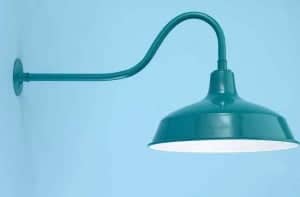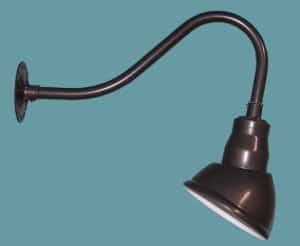Modern barn lights can be used with a restoration project, or to simply illuminate stalls and aisles. In many ways, fixture selection and placement in this setting is similar to most commercial projects, in that the fixtures have to output a lot of illumination efficiently. For restoration projects, where the building may be used for something other than housing livestock, fixture selection may prioritize aesthetics. But if livestock are going to be kept in the building, then aesthetics, obviously, are not the primary concern. Instead, the fixtures need to be reliable and usable next to horses and other animals that may be alarmed by their presence. This takes a special approach for the best results.
LED Barn Lights Make the Most Sense
 Every building is different. Ceiling heights, colors, reflectivity – these are all factors that have to be considered when putting in new or retrofit fixtures. In the past, all kinds of fixtures were used next to livestock, including incandescent bulbs. Today, T5 fluorescent tubes are still a popular option, especially when installed over aisles. However, there is no beating LED technology for both interior and exterior applications. Consider everything that LED can bring to a project:
Every building is different. Ceiling heights, colors, reflectivity – these are all factors that have to be considered when putting in new or retrofit fixtures. In the past, all kinds of fixtures were used next to livestock, including incandescent bulbs. Today, T5 fluorescent tubes are still a popular option, especially when installed over aisles. However, there is no beating LED technology for both interior and exterior applications. Consider everything that LED can bring to a project:
- Excellent longevity – Property owners can’t afford to constantly maintain their fixtures, nor can they afford to replace them every year or two. But that is exactly what most illumination technologies demand. LEDs and T5 fluorescent tubes are far longer lived, and LED even more so. Owners can expect LED fixtures to give, at the minimum, 50,000 hours of performance, and it’s often possible to get up to 100,000 hours.
 No shadows – This is a major issue for buildings that house livestock. Horses are easily spooked by the presence of shadows, so they have to be kept to a minimum. Fixtures that cannot create an even wash of illumination have issues with shadows, but even fixtures that can be controlled have to be placed properly. This is another strength of LED fixtures, as they can be easily arranged to produce even illumination that pushes out all shadows. With photometric analysis, designers can ensure there are no hot or dark spots.
No shadows – This is a major issue for buildings that house livestock. Horses are easily spooked by the presence of shadows, so they have to be kept to a minimum. Fixtures that cannot create an even wash of illumination have issues with shadows, but even fixtures that can be controlled have to be placed properly. This is another strength of LED fixtures, as they can be easily arranged to produce even illumination that pushes out all shadows. With photometric analysis, designers can ensure there are no hot or dark spots.- Quick starting – LED fixtures start up the instant they are switched on. There is no warmup time, which can be a pain to deal with in colder temperatures early in the morning. Whereas most other fixtures require several minutes to get up to full power, and even longer when the temperature drops, LEDs do not.
- Aesthetically versatile – Some barn lights are intended for aesthetic use only, and even here, LED fixtures can be of use. Gooseneck fixtures, for example, are a popular option for exterior restorations, and they can be slotted with LED lamps for continuous use. In short, LED lamps are compatible with fixture housings, allowing for a variety of design options.
LED fixtures have become the primary option for most lighting applications, and it’s no different when it comes to farms and livestock. With their maintenance-free design and quality illumination, LEDs should be the first choice for barns of any size or design.




